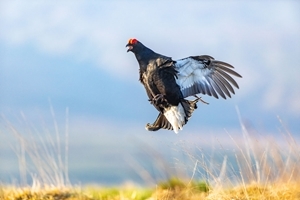 |
| Image credit: Emily Graham Media |
Black grouse was first mentioned in literature in Medieval times, then referred to by their folk names blackcock and greyhen. The species was formally described in 1758 by the Swedish naturalist Linnaeus, who gave it its Latin name Tetrao tetrix, both ancient Greek words for gamebird. In 1832 it was placed in the genus Lyrurus and it is now officially known as Lyrurus tetrix.
Up until the mid-19th Century, black grouse were numerous and widespread across the UK, found on many heaths in southern and eastern England. In fact, leks or mating display grounds could still be found in almost every county in Wales and England, including Middlesex.
The distribution of black grouse was already contracting in the Victorian period and populations began to decline rapidly after the First World War and collapsed after the Second World War due to loss of suitable habitat mosaics through modern and intensified agricultural practice; reduction of keepering; over-grazing by sheep; and afforestation of moorland.
Small pockets held on in the New Forest until the 1930s and on Dartmoor and Exmoor until the 1980s. Black grouse have more recently also been lost from many areas of Wales, southern and central Scotland.